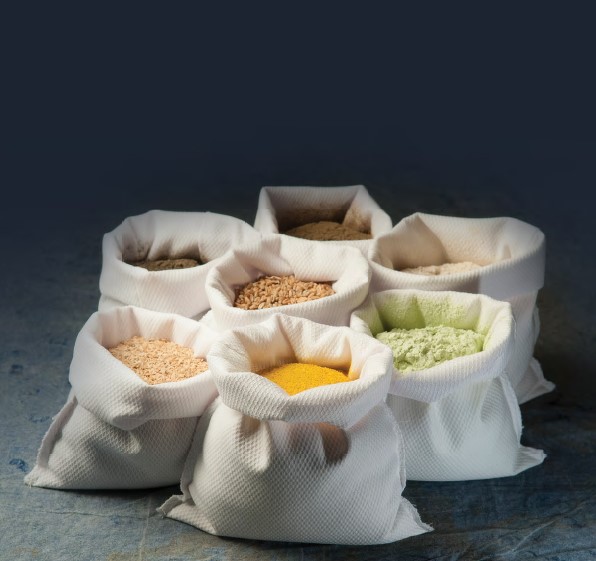Cows can’t compete with fish when it comes to the most sustainable food production for both people and our planet.
Requiring less bone for support in a weightless environment makes fish naturally more efficient than land animals at converting protein and energy into muscle – or meat we can eat.
The muscle-bone ratio also means a greater proportion of the whole fish ends up on our plate compared to livestock – for instance, we can eat almost two-thirds of a salmon compared to only about 40 per cent of the weight of cattle, or just over half a pig.
The imperative to do more with less coincides with warnings of forecast increases in global food production demand beyond the capacity of our planet’s agricultural land use potential.
And with more than 70 per cent of Earth’s surface covered by ocean, aquaculture – one of the oldest ways of producing food as well as one of the most efficient — offers arguably our most sustainable source of animal protein.
All of which make what we feed our farmed fish crucial.
With an industry-leading team of scientists and specialists in fish and prawn health, nutrition and feed production technology, Skretting Australia formulates high-performance feeds for Australian Atlantic salmon, New Zealand Chinook salmon, barramundi, rainbow trout, yellowtail kingfish, abalone and prawn aquaculture industries.
“We formulate our fish feed to provide all the correct nutrients in protein, fat, carbohydrate, vitamins and minerals,” said Melissa Abbott, Tasmanian-based General Manager of the global feed supplier in Australia.
“A critical part of our feed formulations, wheat gluten is a great source of amino acids, which are the basic building blocks to form proteins.”
With a shared commitment to sustainable food production and regional manufacturing industries, Australian family-owned Manildra Group supplies Skretting with locally produced gluten and starches to manufacture nutritious and sustainable aquaculture feed for healthy and delicious Australian fish and prawns.
Manildra Group Accounts Manager Adam Armstrong said there was great potential in Australia’s diverse and thriving aquaculture industry.

One of the fastest-growing primary industries in Australia, aquaculture production has more than doubled since 2006/07 due to Tasmania’s salmon industry.
With Skretting already a world-leading producer of prawn feed, Mrs Abbott said the company looked forward to “exciting market opportunities in Australia for the barramundi and prawn industries”.
“Although these markets account for a smaller proportion of our feed supply, we are actively working with our customers to ensure that feeds maximise production potential and deliver quality and sustainable products for the end-consumer,” she said.
Mrs Abbott said consumer demand for safe, healthy and delicious seafood made “trustworthy, high-quality fish and prawn feeds a prerequisite” for the aquaculture industry.
“Our intention is to source the best possible raw materials for our feed requirements, and our preference is to source from Australia to support regional growers and producers,” she said.
“It’s integral that the raw materials have desired quality specifications which ensure that we manufacture consistent high-quality feeds, and Manildra Group’s range of products perfectly suit these formulation requirements.”
Operating in Australia for more than 25 years, Skretting has also improved feed conversion in aquaculture systems through programs with customers, to prevent feed being wasted.
“We’ve developed advanced feeds that optimise the use of nutrients for fish growth, rather than waste,” Mrs Abbott said. “Our feeds are also highly digestible so more of the feed is converted to the fish, and less is lost to the environment.”
Mr Armstrong said Manildra Group had spent seven decades perfecting extraction of 100 per cent of the grain of wheat – producing value-added products such as gluten and starches that go into Skretting’s aquaculture feeds.
Mrs Abbott said procuring raw ingredients locally had the added supply benefits of high-quality consistent product and logistic efficiencies, including short delivery times to Skretting’s manufacturing site in Tasmania, with more than 70 employees.
With the rapid growth of the industry, the challenge for Skretting Australia is to develop feed solutions that keep pace with market demand for protein, and an evolving production system.
Mrs Abbott said responsible procurement was an important tool for Skretting to meet demands.
“We only source raw materials from responsible suppliers, who must sign our code of conduct detailing our social and environmental expectations – and they are regularly audited,” she said.
“Another of our priorities is identifying and evaluating new raw materials, to avoid over-reliance on any one ingredient.
“Understanding the nutritional requirements of our target aquaculture species and the nutritional profile of raw materials, and a robust research and development program, facilitate this evaluation process.
“As a leading supplier of these feeds, and an essential link in the feed-to-food chain, Skretting has also embedded strong quality assurances and controls into its organisational structure – with all our feed ingredients approved under the Australian stockfeed and pet food regulations, governed by the Australian Pesticides and Veterinary Medicines Authority.”
